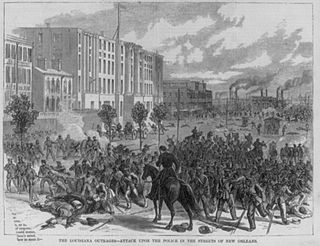This article needs additional citations for verification. (May 2017) |
| Battle of Liberty Place Battle of Canal Street | |||||||
|---|---|---|---|---|---|---|---|
| Part of the Reconstruction Era | |||||||
 The "Louisiana Outrages", as illustrated in Harper's Weekly, 1874 | |||||||
| |||||||
| Belligerents | |||||||
| White League |
| ||||||
| Commanders and leaders | |||||||
| Frederick Nash Ogden | James Longstreet (WIA) | ||||||
| Strength | |||||||
| 5,000 insurgents | 3,500 police officers and militiamen | ||||||
| Casualties and losses | |||||||
|
21+ killed 19 wounded[1] |
11 killed 60 wounded[2] | ||||||
The Battle of Liberty Place, or Battle of Canal Street, was an attempted insurrection by the Crescent City White League against the Reconstruction Era Louisiana Republican state government on September 14, 1874, in New Orleans, which was the capital of Louisiana at the time. Five thousand members of the White League, a paramilitary organization made up largely of Confederate veterans, fought against the outnumbered racially integrated New Orleans Metropolitan Police and state militia. The insurgents held the statehouse, armory, and downtown for three days, retreating before arrival of federal troops that restored the elected government. At least 32 people, including at least 21 members of the White League, were killed in the fighting. No insurgents were charged in the action.
This was the last major event of violence stemming from the disputed 1872 gubernatorial election, after which Democrat John McEnery and Republican William Pitt Kellogg both claimed victory.